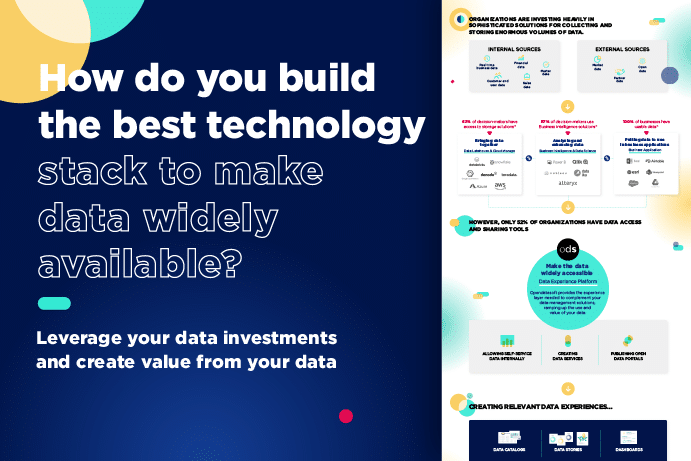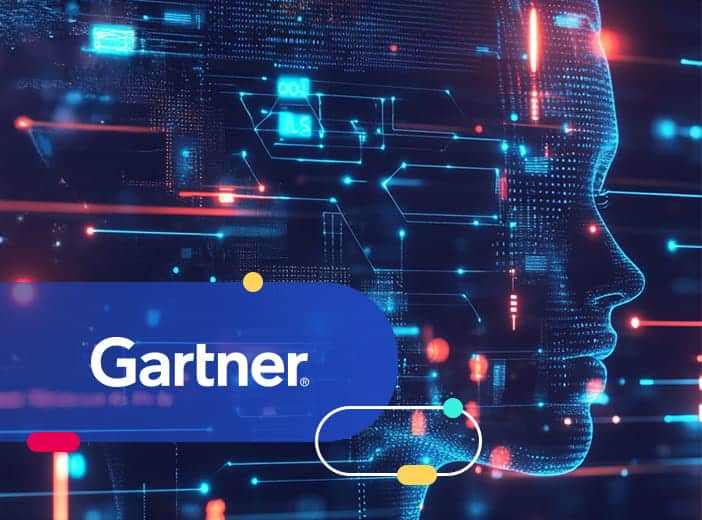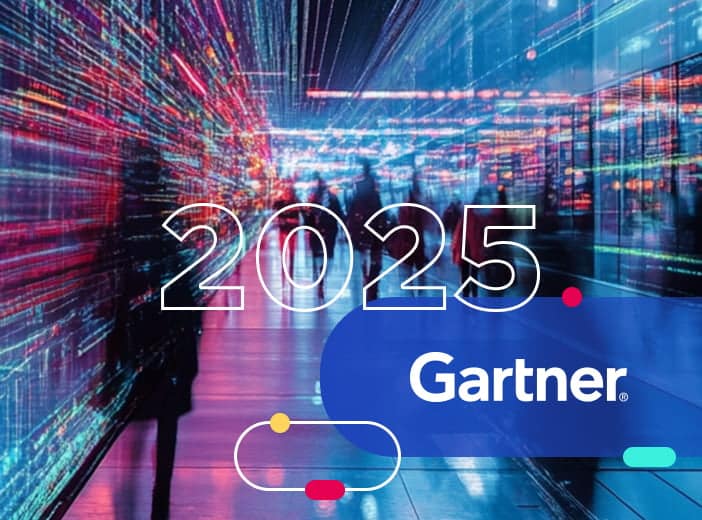How do you build the best technology stack to make your data widely available?
Organizations are investing heavily in sophisticated solutions for collecting and storing enormous volumes of data. But are these investments worthwhile? Do they release data’s full potential and value?

According to our latest study, only 50% of large public and private organizations have a clear strategy for putting their data to use in ways that allow internal and/or external stakeholders to utilize it very easily. To gain real benefit data has to be as available and accessible as any other type of information.
Why is data still being underutilized given that most organizations have already deployed a range of data solutions? What is the missing piece of the puzzle to unlock your data’s potential and to reap the benefits of existing technology investments?
Discover the infographic :
Why are organizations struggling to create value from their data?
Each and every day, every organization produces large amounts of data that anyone can potentially use, including employees, citizens, customers, partners, and other stakeholders.
There are a number of factors to consider when picking solutions to maximize value from this data. These include ensuring data quality, enhancing data, being able to create advanced visualizations, and the ability to share data with as many people as possible, in multiple formats and through all possible channels.
However, one thing is clear: existing investments fall short of releasing data’s full potential. Too often, data is siloed within organizations and accessible only to experts such as data analysts and data scientists.
This is particularly evident in our latest study, which found that 40% of decision-makers are unhappy with the complexity of the data tools used within their organizations.
Creating value from data is about more than just collecting it or using it in your day-to-day business.. Internal and external stakeholders need to be able to utilize data very easily—as with any other information—in the form of understandable visualizations that can be quickly shared digitally.
Existing solutions do not allow data to be widely accessed and used
Your current information system normally allows you to use all your data by:
- Consolidating it within a data lakehouse/warehouse, with cloud storage or through data integration tools
- Analyzing and enhancing it with Business Intelligence tools
- Allowing its use for business purposes through business applications
Putting data to use in business applications
100% of businesses create usable data through their day-to-day activities. Whether it is the sales team using CRM to understand and build customer relationships, field agents reporting issues via synchronized forms with Airtable, or employees using other business systems, organizations have a range of systems that are creating data every day.
Bringing data together: data lakehouse, cloud storage, and data integration
62% of decision-makers have access to data storage solutions. Organizations that produce and collect large amounts of data understand that they must adopt solutions that group this data together in one place, such as a data lakehouse/warehouse, cloud storage, or through data integration.
These solutions are essential for processing massive amounts of data, but they are accessible only to experts, who cannot meet all of the organization’s business needs around data on their own.
Analyzing and enhancing data: BUSINESS INTELLIGENCE & DATA SCIENCE
57% of decision-makers use Business Intelligence solutions. BI and data science tools allow you to enhance your data and use it to highlight the challenges and opportunities that face your organization. Using predictive AI algorithms allows you to take this analysis a step further, empowering accurate decisions around future business strategy.
As with storage solutions such as data lakehouses, BI and data science tools are used and managed by experts. A considerable amount of their valuable time is therefore spent on gathering and sending data in the right format to meet the needs of each business team. In fact, three-quarters (76%) of data experts say that they spend half their time creating reports for business teams.
Organizations are failing to update their existing models or move to a true data-driven approach that would increase efficiency and help their employees make better decisions on a day-to-day basis.
To release data’s full potential, it is not enough to simply collect and analyze it. Data must be made understandable, accessible, and reusable by as many people as possible through tools that expand data access and use.
The missing link: A data experience platform
Despite the investments that have already been made, 63% of employees say they can’t gather the information they need to make decisions in the right format quickly enough. Only 14% of organizations report that they give their employees full access to all their data.
And for good reason…
Only 52% of organizations have data access and sharing tools at their disposal. A data experience platform provides the experience layer needed to complement existing data management solutions and ramp up the use and value of data.
Opendatasoft is an all-in-one platform that lets you:
- Connect all your data sources together
- Prepare data by combining different datasets and improving their quality
- Publishing that data and managing its access based on the needs of your stakeholders
- Allowing data to be viewed in different formats according to the information needs of your target audience
- Sharing the data with your chosen stakeholders on all channels, irrespective of their levels of skills and expertise
Create new uses from your data to meet all your needs
A data experience platform such as ODS allows you to create tangible uses for your data, for example:
- Providing self-service data internally so that all your employees can easily access and use fact-based information in their daily activities
- Creating data services to boost your efficiency, attractiveness to partners, and overall competitiveness
- Publishing open data portals to communicate transparently with as many people as possible
With the right data formats, you can transform your data into clear insights that are both accessible and actionable.
CAPTURE FORMATS, DATA STORIES, DATA CATALOGS, DASHBOARDS, MAPS…
You can then share data securely with multiple access levels, tailored to the needs of your internal and/or external stakeholders. Disseminate that data through channels that promote its reuse, in ways that are easy to understand by consumers, customers, citizens, the media, business partners, subsidiaries, employees, board directors, investors, and more.
CAPTURE SITE, EXPORTS, AND APIs
The goal is to allow everyone to use data for their personal and/or professional needs, regardless of their expertise.
From sourcing to sharing, our all-in-one platform empowers everyone in organizations to quickly create digital data experiences for all internal and/or external stakeholders, ranging from technical experts to the general public.
Want to learn more about our platform? Schedule your demo!




